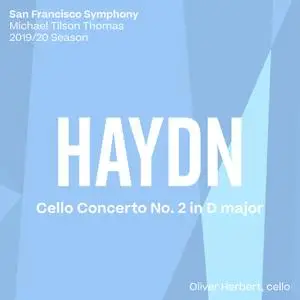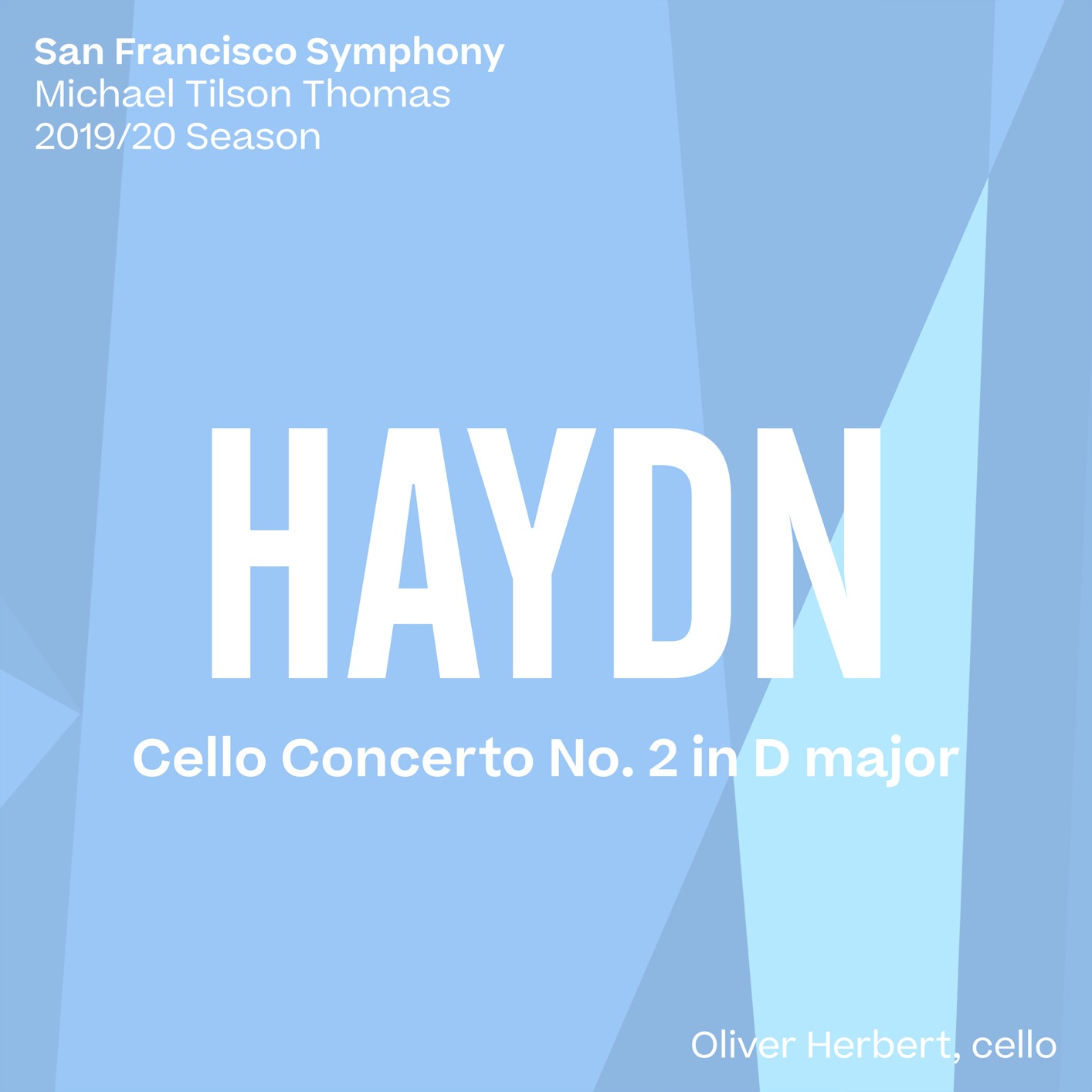San Francisco Symphony & Michael Tilson Thomas - Haydn: Cello Concerto No. 2 (2020)
WEB FLAC (tracks) - 100 Mb | MP3 CBR 320 kbps - 57 Mb | 00:24:37
Classical | Label: SFS Media
WEB FLAC (tracks) - 100 Mb | MP3 CBR 320 kbps - 57 Mb | 00:24:37
Classical | Label: SFS Media
Franz Joseph Haydn’s outpouring of music during his three decades as musical director for the rich and powerful Esterházy princes is breathtaking, encompassing long lists of symphonies, chamber pieces, and operas. Concertos were also well represented, a fact that would surprise many modern listeners since his concertos are by and large ignored today. Both of Haydn’s extant cello concertos arrived at modern concert halls with complicated musicological baggage attached. His splendid Cello Concerto No. 1 in C major lay in oblivion for perhaps two centuries, known through an entry in his catalogue that enabled it to be dated to 1765 at the latest, but given up for lost until its manuscript resurfaced in 1961. His D major Cello Concerto, the work heard in this concert, was accordingly accepted during that span as his only surviving work in the genre, but even it ran into problems.Tracklist:
Haydn’s inscription on the first page of this concerto’s manuscript confirms that it was written in 1783. But, as with the C major Concerto, the manuscript for the D major Concerto went missing. The D major, however, had appeared in print during the composer’s lifetime, issued by the publisher Johann André in 1804 with the notation that the engraving had been made “after the author’s original manuscript.”
It seems possible—even likely—that André was given the manuscript by Anton Kraft (1749–1820), the cellist for whom the piece had been composed. For a time, some maintained that the D major Cello Concerto had actually been composed by Kraft rather than Haydn. This misinformation proved hard to eradicate, and it was repeated in other publications so often that it came to overshadow the truth, although a few voices continued to argue that Haydn’s Cello Concerto really was by Haydn after all. Meanwhile, Haydn’s manuscript was wending its way through various collections, mostly out of sight to the rest of the world. At some point it landed in the Austrian National Library, and in 1954 the director of the library’s music division, Leopold Nowak published an article that brought the manuscript to light once again and put to rest any doubts about Haydn’s authorship.
THE MUSIC We would do well to accept that Haydn set out to create an individual sound-world in his D major Cello Concerto, one that was indeed less taut than what he was producing in his symphonies and string quartets at the time. This may derive from the simple fact that he is writing a concerto for cello, an instrument very easily buried if the orchestral texture is not kept in check. The soloist is never required to shout in order to be heard above the deferential accompaniment (the winds are even marked dolce at a couple of spots), even as he moves through the spacious first movement’s sparkling scale passages and pirouettes at the top of the register. Haydn calls for a single note to be played in harmonics (or “flautino,” to use Haydn’s term)—a very high G, just a bit before the cadenza. As Haydn biographer H.C. Robbins Landon writes, “the ’cello part was certainly ‘tailor-made’ for Kraft, and all those brilliant technical effects . . . show that this is a typical eighteenth-century attempt on the part of the composer to display the talents, tone and musicianship of his soloist.”
The slow movement shows off the cello’s still gentler side, capitalizing on the solo instrument’s native ability to spin out a cantabile line. At the outset, Haydn effects an imaginative touch by instructing that the first violin line should momentarily be entrusted to a single instrument.
The concluding rondo movement, built out of an apparent hunting motif, also eschews complication, although a dose of nervousness is built up in the course of an episode in the minor mode. As in the first movement, Haydn makes considerable demands on the soloist’s nimbleness, and in this finale he incorporates some technically challenging passages involving double stops and playing in octaves.—James M. Keller
1. Cello Concerto No. 2 in D Major, H. Vllb:2, Op. 101: I. Allegro moderato (13:59)
2. Cello Concerto No. 2 in D Major, H. Vllb:2, Op. 101: II. Adagio (05:41)
3. Cello Concerto No. 2 in D Major, H. Vllb:2, Op. 101: III. Rondo (Allegro) (04:56)
–––––––––––-
DON'T MODIFY THIS FILE
–––––––––––-
PERFORMER: auCDtect Task Manager, ver. 1.6.0 RC1 build 1.6.0.1
Copyright © 2008-2010 y-soft. All rights reserved
ANALYZER: auCDtect: CD records authenticity detector, version 0.8.2
Copyright © 2004 Oleg Berngardt. All rights reserved.
Copyright © 2004 Alexander Djourik. All rights reserved.
FILE: 03 - San Francisco Symphony & Michael Tilson Thomas - Haydn- Cello Concerto No. 2 in D Major, Hob. Vllb-2- III. Rondo (Allegro).flac
Size: 22472673 Hash: C7D249D000F78FC9341CCB496438BB3F Accuracy: -m0
Conclusion: CDDA 99%
Signature: 5A91980DB4CF21DEF2CF96755BE09A8FE7DAEC4C
FILE: 02 - San Francisco Symphony & Michael Tilson Thomas - Haydn- Cello Concerto No. 2 in D Major, Hob. Vllb-2- II. Adagio.flac
Size: 21987308 Hash: 5A07ED13A21DB9A9611AB16375FAE184 Accuracy: -m0
Conclusion: CDDA 99%
Signature: CA79EE166ED7E34B256ED20638EF62AADD83D6BC
FILE: 01 - San Francisco Symphony & Michael Tilson Thomas - Haydn- Cello Concerto No. 2 in D Major, Hob. Vllb-2- I. Allegro moderato.flac
Size: 60049603 Hash: 2E1626DA1DAA2B915FC883AAF8D18D4B Accuracy: -m0
Conclusion: CDDA 99%
Signature: C9771730A3F16B08645E679C940A267A47C1B863
DON'T MODIFY THIS FILE
–––––––––––-
PERFORMER: auCDtect Task Manager, ver. 1.6.0 RC1 build 1.6.0.1
Copyright © 2008-2010 y-soft. All rights reserved
ANALYZER: auCDtect: CD records authenticity detector, version 0.8.2
Copyright © 2004 Oleg Berngardt. All rights reserved.
Copyright © 2004 Alexander Djourik. All rights reserved.
FILE: 03 - San Francisco Symphony & Michael Tilson Thomas - Haydn- Cello Concerto No. 2 in D Major, Hob. Vllb-2- III. Rondo (Allegro).flac
Size: 22472673 Hash: C7D249D000F78FC9341CCB496438BB3F Accuracy: -m0
Conclusion: CDDA 99%
Signature: 5A91980DB4CF21DEF2CF96755BE09A8FE7DAEC4C
FILE: 02 - San Francisco Symphony & Michael Tilson Thomas - Haydn- Cello Concerto No. 2 in D Major, Hob. Vllb-2- II. Adagio.flac
Size: 21987308 Hash: 5A07ED13A21DB9A9611AB16375FAE184 Accuracy: -m0
Conclusion: CDDA 99%
Signature: CA79EE166ED7E34B256ED20638EF62AADD83D6BC
FILE: 01 - San Francisco Symphony & Michael Tilson Thomas - Haydn- Cello Concerto No. 2 in D Major, Hob. Vllb-2- I. Allegro moderato.flac
Size: 60049603 Hash: 2E1626DA1DAA2B915FC883AAF8D18D4B Accuracy: -m0
Conclusion: CDDA 99%
Signature: C9771730A3F16B08645E679C940A267A47C1B863



